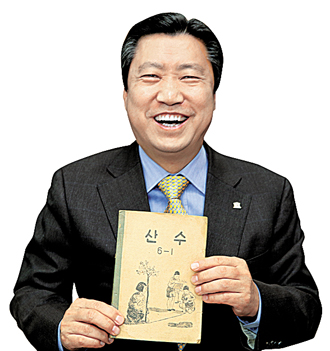Korean Unesco panel to fund education programs

Secretary General Min Dong-seok, of the Korea National Commission for Unesco, holds a sixth-grade math textbook that was published in 1954, right after the Korean War, with support from Unesco.Provided by KNCU
“Unlike 60 years ago, when we were supported by Unesco headquarters [in Paris], we are planning to help underdeveloped countries starting this year,” Min Dong-seok, secretary general of the commission, said on Feb. 2. “This is the first case in which an individual national commission has raised funds [for aid].”
In a detailed briefing on the same day, Min announced that Unesco will raise 5 billion won ($4.6 million), collecting funds from independent donors or corporations. The money raised will go toward local education centers in underdeveloped nations in Africa and Asia to eradicate illiteracy and promote vocational training programs, he added.
Korea is ranked 13th out of 199 countries when it comes to the amount of aid raised. Currently, the KNCU is focusing its efforts on the Sejong Project, with funding from the Ministry of Education, Science and Technology, which aims to root out illiteracy in countries such as Nepal, Bhutan and Pakistan.
But the commission, which aims to carry out Unesco’s goals in Korea, has a long history in the nation. In 1954, the KNCU built a school textbook factory in Daebang-dong, Seoul, with financial support from Unesco headquarters. It was one of the first major projects implemented in Korea by the organization after the 1950-1953 Korean War.
“Korea still exists today thanks to the books that Unesco made at the time,” said UN Secretary General Ban Ki-moon. During his 2012 Paris visit, he donated one of the textbooks from the period to Unesco headquarters as a symbol of the nation’s gratitude.
The commission has also advised Unesco over the designation of Korean cultural heritage - particularly when the organization included Seokguram Grotto and Jongmyo Shrine on its list of World Heritage sites, and again when the Hunmin Chongum Manuscript and Nanjung Ilgi were included on the Memory of the World Register. Korea has 11 items listed on the register, the most among Asian countries and the fifth-most worldwide.
“Seokguram Grotto was designated [as a World Heritage item] after it had been restored over the course of three years by an expert we invited here,” Min said. “Based on such experiences, we are now participating in discovering archived heritage in underdeveloped countries and registering those items on the Memory of the World Register.”
The commission has supported North Korea since 2002, donating equipment and paper for textbook printing, though the program was halted in 2009 as the relationship between the two Koreas deteriorated.
The panel also set up an overseas volunteer youth program in 1989, which the Korea International Cooperation Agency later merged with two similar programs and began coordinating.
BY KIM KI-HWAN [bongmoon@joongang.co.kr]










with the Korea JoongAng Daily
To write comments, please log in to one of the accounts.
Standards Board Policy (0/250자)